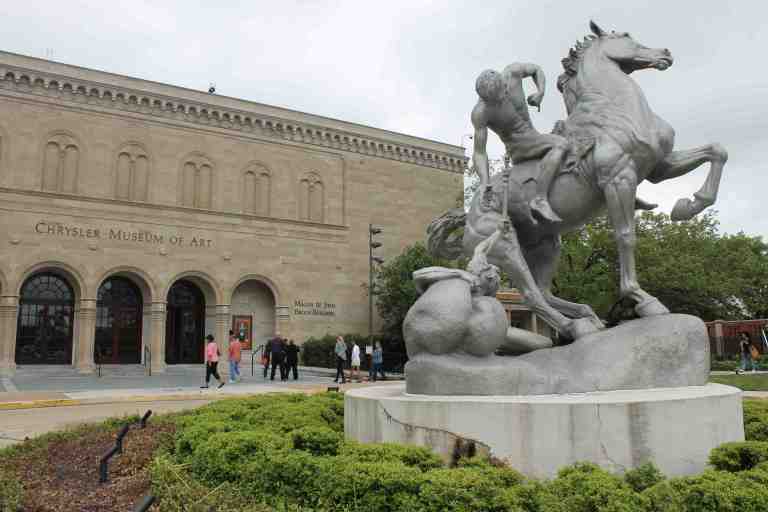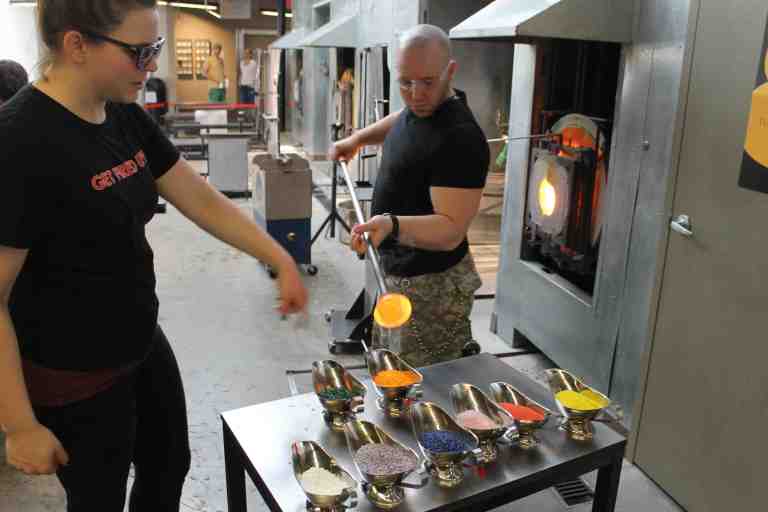What comes to mind when I say “Norfolk, Virginia?” The Hampton Roads? It’s one of the largest natural harbors in the world. The Navy base? I always did like a man in uniform. But what about the glass?
Before I visited Norfolk, the only thing I knew about it was it had the biggest Navy base in the country. When I left, I had a nifty glass candy bowl I blew myself. I had always thought of Corning, NY, as the center for the American glass industry, or maybe Seattle (it’s where glass artist extraordinaire Dale Chihuly calls home). But as it turns out, the minute you step into the Norfolk city limits, you will not be able to get away from the stuff.

In the Navy?
I got the feeling that the whole glass-thing was a a bit of identity-creation on the part of Norfolk, a way for the town to be — no offense — something else, anything else, other than one-note Navy town. Of course, you could douse the whole place in glass and still not be able to get away from men (and women) in uniform; there was an aircraft carrier in drydock, and the USS Wisconsin, a World War II Iowa-class battleship, is moored to the waterfront as a museum. For the exploding art scene in town, it’s an uphill climb. But boy, does it look good.
And one of the reasons it does is thanks to the Hampton Roads itself. Less of a single bay than than a grab-bag of coves, inlets, and estuaries all jammed together, it’s hard to get away from the water no matter which direction you go or city you are in (nine ring the Roads). It creates a picturesque effect; Norfolk seems laced with manicured canals and waterways lined with blooming trees and stately Colonials. And the Chrysler.

The Art of Inclusion
Compared to other institutions of culture (the Met, the Getty, the Barnes), the Chrysler Museum of Art is a downright toddler, having only opened its doors in 1971. There’s a story here: Walter Chrysler, Jr, the son of auto magnate Walter Percy Chrysler, who went on a shopping spree of European art as a way to deal with his failed marriage (that may have had something to do with the fact he was gay…). In 1958, he bought a disused church in Proveincetown, and crammed space to bursting.
Treating his art like a baseball card collection, Chrysler would trade works willy-nilly for anything that caught his eye. That wasn’t always the best policy, but word got around of his collection, and in stepped Norfolk offering its Museum of Arts and Sciences as a new, spacious, and easily-accessible forum for his collection. Chrysler moved the whole collection lock, stock, and barrel to Virginia, and the rest is history.
And with two expansions since 1971, and now counting over 10,000 pieces to its name, the museum is wildly eclectic, largely thanks to the mercurial eye of Chrysler (who passed away in 1988). But any museum worth its salt will have the usual ancient Greek statues, Picassos, Tiffanys, and Renaissance pieces, what sets this museum apart from all the other museum with other ancient Greek statues, Picassos, Tiffanys, and Renaissance pieces is the Chryslers use of “inclusions.”

The Chrysler is unique in how it brings ancient art forward in time and pushes cutting-edge art back. The museum pairs art of a bygone era are similar pieces done in very contemporary style — and in true Norfolk style, all in glass. The most iconic example reaches across two thousand years: Atop many Roman sarcophagi are reclining figures, models of the dearly departed in life. At the Chrysler, such a monument is twinned with a modern glass sculpture of a woman lying on her side, propped up on one elbow. One pose could have been a reference for the other. It shows how some artistic tropes ring through the ages and even beyond death itself.
Blow, Gabriel, Blow!
Glass is surprisingly versatile; not only can it be blown or spun, but you can even paint with it. One wing of the Chrysler is dedicated sole to everything you can do with glass, and “everything” can often mean “anything.” There was a painting, all of glass, that recalled the images of Lascaux. Another painting was inside a glass sculpture, and looked like a medieval star chart. And then there were all the Wedgeworth-esque cameos. Some pretty amazing stuff. Some of the glass I saw was born in the forges of the Perry Glass Studio, just a short walk from the Chrysler, and sort of an art lab for the museum as well. If you have never seen molten glass, it is totally awesome.
Looking like liquid light, molten glass is incandescent but see-through, intensely hot but without any sort of flame; it has the mind-bending ability to “not look hot” while incinerating anything it touches (and coming fresh from a furnace. From a distance, it looks just like glass with a bright, orangey-yellow tint to it.

The objective was for me to blow my own softball-sized candy bowl (and not burn the studio down in the process). Right away there was a trick to it: I was making something spherical, so once I pulled a dollop of glowing glass onto my plowpipe, I had to constantly spin it to make sure it kept its shape. Even then, the staff have molds to help keep everything symmetrical because the medium has the consistence of honey.
In fact, the only time I wasn’t spinning was the precious few seconds I had to dip my still hot-as-hell ball of glass in a series of — swear to God — gravy boats filled with chips of colored glass in every hue. I chose two, then quickly thrust the whole thing back into the forge to melt the chips. Spin, spin, spin.
Then on to the actual blowing — and Trick #2. You don’t just take in a lungful of air and blast it out down the blowpipe. That would pop the bubble I was trying to make. Instead, I had to let out a series of gentle puffs, plus more of the spinning, to get a nice, round sphere (with some help from a mold). Once I got the right size and shape, it was quick work by the staff with a bowl push to press half of my sphere back into itself to create a basin, quicker work with a series of medieval tongs and clippers to “cut-carve” the bowl from the blowpipe, and with another set of thongs, tap my bowl onto another blob of glass to act as the foot. And voila!

Still took a day to cool down. That was the crazy thing; I was there by the forge, saw the glass in the forge, pulled the glass out of the forge, felt the heat from both, and never once did my glass look hot. But it was hot enough to need a full 24 hours to slowly radiate the heat away. Too fast and it would break; you don’t dunk hot glass in water you do metal unless you want an explosion of glass shrapnel going in every direction.
So, the next day I swung by the museum for my physical and room-temperature reminder of my new impressions of Norfolk. It’s my shelf as we speak. It’s perfect for the dru…I mean the co…gummy bears! Yes. That is what I meant. Gummy bears.

I love the pictures on this blog.Makes me want to go to this place.
LikeLike
Thank you! It’s a great little city.
LikeLike